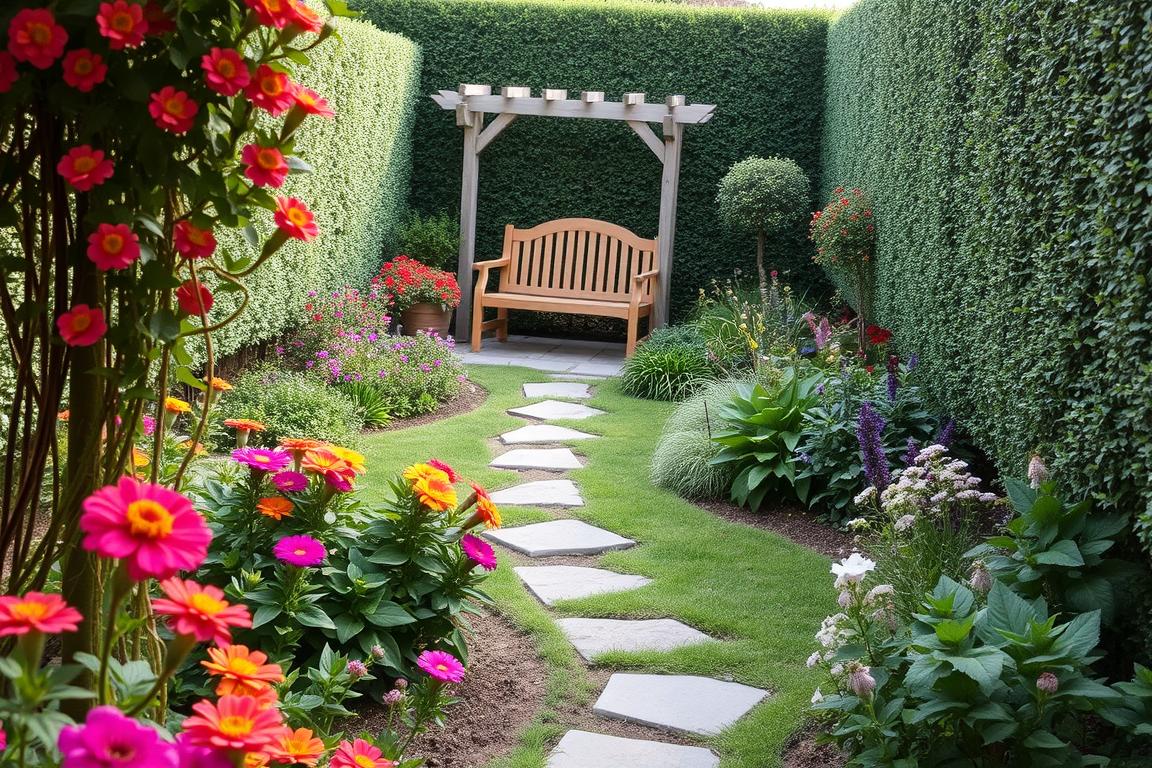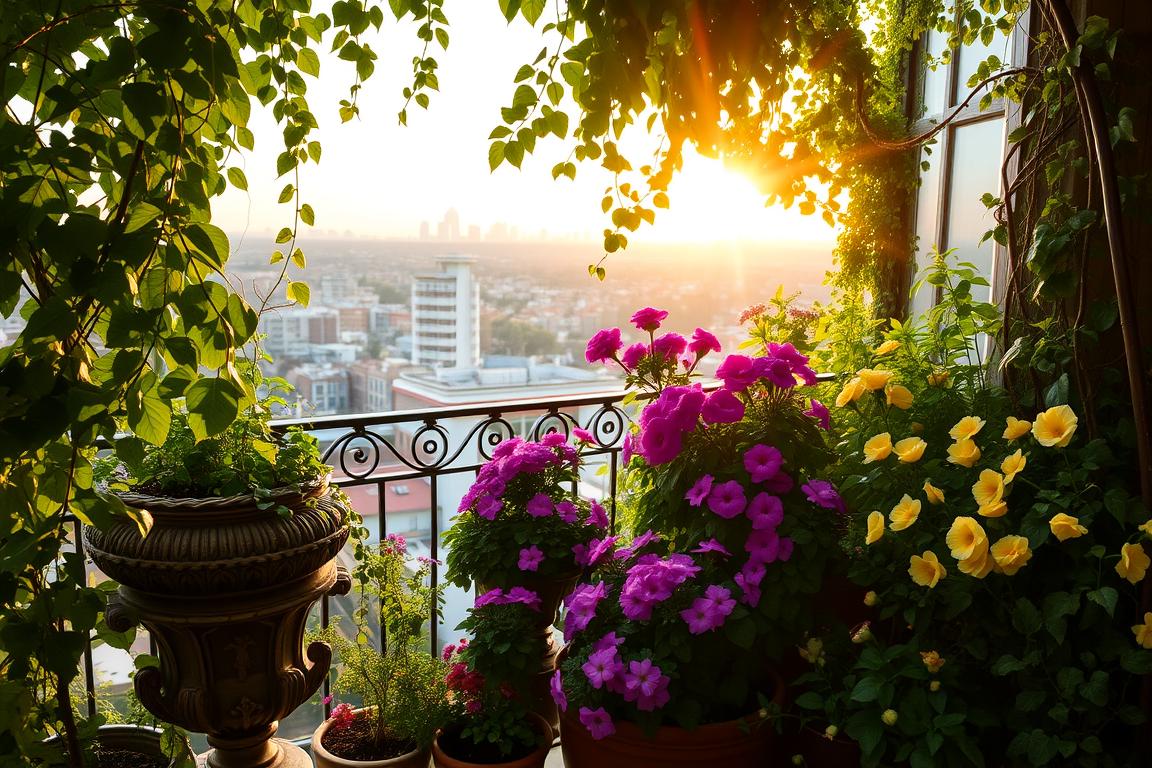Looking to make your living space better? Biophilic design is a great choice. It brings nature into your home, improving your life. It’s easy to start with biophilic design, making your home more natural.
Using biophilic design can make you feel better and help the planet. It adds natural elements, reducing stress and improving air. Whether you’re redoing your whole home or just a bit, biophilic design is a good start. It makes your home look great and supports a healthy lifestyle.
Table of Contents
ToggleIntroduction to Biophilic Design
Biophilic design reconnects us with nature. It makes your home look good and feel good. With biophilic design, you can add natural light and organic shapes to your home.
Key Takeaways
- Biophilic design principles for beginners can help you create a space that connects you with nature
- Incorporating natural elements can reduce stress and improve air quality
- Biophilic design can increase your sense of calm and well-being
- Natural light is a key element of biophilic design
- Organic forms and patterns can add visual interest to your space
- Biophilic design principles for beginners are easy to learn and implement
Understanding Biophilic Design Principles
Exploring biophilic design means learning its key principles. This design aims to connect us with nature, improving our lives. It boosts air quality, lowers stress, and boosts well-being.
Defining Biophilic Design
Biophilic design uses natural elements like light, water, and plants in buildings. It’s based on our natural love for nature. This approach makes spaces healthier and more sustainable.
Historical Context of Biophilia
Biophilia dates back to ancient times, where people lived with nature. Knowing its history helps us see its value in today’s designs. It leads to healthier, happier, and more sustainable spaces.
Key Elements of Biophilic Design
Biophilic design brings nature into your space. It’s about creating a harmonious and sustainable environment. To start, you need to know the core elements that connect us to nature.
Key elements include natural light, spatial configuration, and organic forms. These elements make your space beautiful and promote well-being. For instance, using large windows or skylights lets in natural light. This reduces the need for artificial lighting and adds warmth.
Other important elements are:
- Natural materials, such as wood and stone
- Organic patterns, like those in nature
- Connection to nature, through views or outdoor spaces
By using these elements, you can make a space that’s beautiful, sustainable, and healthy. Whether it’s your home or office, biophilic design improves your well-being and the environment.
Incorporating Plants in Your Space
Adding plants to your space is a smart move for Biophilic Design. It brings nature indoors, making your area peaceful and calming. This helps improve your well-being. Plants are a simple way to connect with nature, as Biophilic Design Concepts suggest.
Choosing the Right Indoor Plants
Some easy-to-care-for plants for indoors are:
- Succulents
- Air plants
- Snake plants
These plants do well in different light conditions. They’re great for indoor spaces.
Placement and Arrangement Tips
Here are some Biophilic Design Tips for your plants:
- Put plants near natural light for best benefits
- Use plants to separate areas in a room
- Group plants for a lush, natural feel
Follow these tips to make a space that’s both beautiful and functional. It will incorporate nature’s benefits.
Utilizing Natural Materials
Biophilic design uses natural materials to make spaces beautiful and sustainable. You can find many examples that show how wood, stone, and textiles add warmth and texture. This approach makes your space look good and helps the environment.
Using reclaimed wood for furniture and floors is a great idea. Stone features like walls or fireplaces add elegance. Natural textiles, like woven baskets and jute rugs, add depth and interest. These materials connect you to nature, making your space calm and relaxing.
Think about using eco-friendly materials like recycled ones and sustainable wood. This reduces waste and helps the environment. By choosing these materials, you create a beautiful and sustainable space. Examples include living walls, green roofs, and natural ventilation systems.
Creating Views of Nature
Exploring Biophilic Design Principles for Beginners shows how key it is to have views of nature. You can do this by smartly placing windows and designing them. This lets natural light in and shows off beautiful outdoor scenes. It helps you feel connected to nature and boosts your well-being.
Window Placement and Design
Think about where and how you design your windows. Big windows or sliding glass doors give you a clear view of the outdoors. Smaller windows can highlight certain outdoor spots, like a garden or a tree. Orientation matters too, as it affects how much sunlight and warmth your space gets.
Utilizing Scenic Artwork
You can also use scenic artwork to bring nature inside. This could be nature-themed paintings, photos, or prints. Adding these elements can make your space feel calm and peaceful.
By using these tips and Biophilic Design Principles, you can make a space that’s good for your health and connects you to nature. Always think about your space’s unique features and the outdoors when designing your views.
Water Features in Biophilic Design
Water features can make a space feel calm and peaceful. They help reduce stress and improve mental health. By adding water features, you can enjoy the benefits of biophilic design. This includes a sense of calm and well-being.
The Sound of Water
The sound of water is very soothing. You can get this sound from fountains or waterfalls. It helps block out background noise and brings peace, which is a key benefit of biophilic design.
Types of Indoor Water Features
There are many indoor water features to pick from. Here are a few:
- Tabletop fountains
- Wall-mounted fountains
- Indoor waterfalls
Think about your space’s size and style when choosing a water feature. Also, consider how much upkeep it needs. Adding water features to your design can make your space more relaxing and healthy.
Color Schemes Inspired by Nature
Color schemes are key in biophilic design, making spaces feel connected to nature. Using earthy tones and natural materials helps create a peaceful atmosphere. Biophilic Design Tips recommend colors like green, brown, and beige to warm up a space.
Earthy Tones and Their Impact
Earthy tones greatly affect a space’s feel. They bring calmness and serenity, making a space welcoming. Here are some examples:
- Green: a calming and balancing color that promotes growth and harmony
- Brown: a warm and comforting color that evokes feelings of stability and security
- Beige: a neutral and soothing color that creates a sense of calmness and tranquility
Seasonal Color Palettes
Seasonal color palettes add harmony and balance to a space. They reflect the changing seasons, making a space lively and engaging. For instance, winter might use cool blues and whites, while summer might use warm yellows and oranges.
Natural Ventilation and Air Quality
Exploring Biophilic Design Concepts shows us how vital natural ventilation and air quality are. By using Biophilic Design Examples that focus on fresh air, you can greatly boost health and happiness. This is done by smartly placing windows, doors, and vents for better airflow.
Natural ventilation helps cut down on the need for mechanical systems. This saves energy and connects us more to the outdoors. It’s a core part of Biophilic Design, making us feel closer to nature.
- Strategic window placement to capture prevailing breezes
- Using vents and clerestory windows to enhance cross-ventilation
- Incorporating shading devices to reduce heat gain and minimize the need for air conditioning
Adding these Biophilic Design Examples to your space makes it healthier and greener. It’s good for both people and the planet.
Lighting Strategies for a Natural Feel
Lighting is key in biophilic design. As a beginner, learning to use light for a natural feel is vital. Biophilic Design Principles for Beginners highlight the need for natural light. But what if your space lacks natural light? That’s where daylight simulation and adjustable lighting come in.
Daylight Simulation
Daylight simulation uses artificial light to mimic natural daylight. This can be done with special light bulbs or systems. It brings warmth and coziness to your space, a core part of Biophilia in Design. Benefits include:
- Improved mood and reduced stress
- Increased energy and productivity
- Enhanced sense of well-being
Using Adjustable Lighting
Adjustable lighting lets you change light intensity and color. This is great for biophilic design, aiming to connect you with nature. It allows you to mimic day’s light changes, from sunrise to sunset warmth. Biophilic Design Principles for Beginners suggest adjustable lighting for flexibility and adaptability.
Biophilic Design in Outdoor Spaces
When you bring biophilic design to outdoor areas, you make a smooth transition between inside and outside. This blend of nature and built environment not only looks great but also boosts your mental health and well-being.
Creating a Garden Oasis
To make a garden oasis, add natural elements like plants, water features, and natural materials. Use plants with different textures and colors to make your garden interesting. Mix flowering plants, shrubs, and trees for a layered look.
Seamless Transition Between Indoors and Outdoors
To link indoors and outdoors smoothly, use similar materials and design in both. For example, use wood or stone for outdoor furniture and decor. Then, bring these elements inside through flooring, walls, or decor. This creates a unified design that flows well, making biophilic design easy to live with.
Mindfulness and Biophilic Design
Exploring biophilic design can greatly improve your well-being. By adding natural elements and Biophilic Design Elements, you can make a space for mindfulness and relaxation. Biophilic Design Tips help you create a calm and nature-connected environment.
Imagine entering a room that feels like a peaceful oasis. Here, the daily stress fades away. Biophilic design makes this possible. It uses natural materials, colors, and textures to create a calming space.
Encouraging a Sense of Calm
To bring calm, use soft colors, natural textures, and gentle lighting. Adding plants, water features, or other natural elements helps too. Follow Biophilic Design Tips to make a peaceful space.
Spaces for Reflection and Relaxation
It’s key to have areas for quiet reflection and relaxation. Design a quiet room or corner with comfy seating, natural light, and soothing colors. Use Biophilic Design Elements like a living wall or water feature to connect with nature.
Sustainable Practices in Biophilic Design
Starting your biophilic design journey means thinking about the environment. You can make a space that connects you to nature and is good for the planet. Using eco-friendly materials and reducing waste are key. For example, reclaimed wood or bamboo adds beauty and supports sustainability.
There are many ways to make your design sustainable. Here are a few ideas:
- Use energy-saving lights and appliances.
- Add natural ventilation and air cleaners.
- Choose materials with low VOCs and can be recycled.
- Start a recycling program for waste.
By choosing sustainable practices, you can make a design that’s beautiful, useful, and eco-friendly. Every choice you make matters. As you look at Biophilic Design Concepts and Examples, remember to focus on sustainability. Aim to create a space that blends well with nature.
Designing Multifunctional Spaces
Exploring biophilic design means focusing on spaces that do more than one thing. By using Biophilic Design Principles for Beginners, you can make a space that feels connected to nature. It’s great for small homes or apartments where space is tight.
Designing spaces that do it all requires thinking about Biophilia in Design. You can add plants, natural materials, and lots of light. This way, your space will be useful and good for the planet.
- Flexibility in layouts: Use furniture that can change its use or be moved around.
- Integrating nature: Add plants, natural materials, and lots of light to feel connected to nature.
- Sustainability: Pick materials and designs that are good for the environment.
By following these tips, you can make a space that looks good, works well, and is kind to the planet. Always keep the Biophilic Design Principles for Beginners and Biophilia in Design in mind. This way, your space will feel connected to nature.
Biophilic Design Tools and Resources
Exploring biophilic design opens up a world of tools and resources. These help you create spaces that enhance your life. Understanding the principles and elements of biophilic design is key. This way, you can make a space that looks good and boosts well-being and productivity.
Designing your space is easier with the right apps and software. Some top picks include:
- Room sketching software to help you plan your layout
- Color palette generators to find the perfect earthy tones
- Plant identification apps to choose the right plants for your space
There are also many books and websites on biophilic design. These offer valuable insights and inspiration. They help you learn how to apply biophilic design in your space. By diving into these resources, you’ll understand the benefits of biophilic design better.
Getting Started with Biophilic Design
To start with biophilic design, assess your space first. Think about how to add natural elements. By learning about biophilic design, you can make a space that improves your well-being and productivity.
Case Studies: Successful Biophilic Designs
Exploring biophilic design means looking at projects that use nature. These examples show how to connect with nature indoors. Elements like natural light and organic shapes help create calm and well-being.
To use biophilic design, think about the right materials and plants. Reclaimed wood and living walls bring nature inside. Adding stone and water features also brings peace.
Successful designs include homes with big windows and sliding doors. These let in light and show off the outdoors. Offices and restaurants also use biophilic design, like living walls and green roofs, to improve well-being.
Real-World Examples
- Homes with green roofs and solar panels
- Offices with living walls and natural ventilation
- Restaurants with outdoor seating areas and natural materials
By using biophilic design, you can make a space that’s good for your health and the planet. Think about your space’s needs and get creative with biophilic design.
Getting Started with Your Biophilic Design Project
Starting a biophilic design project is thrilling. It can turn your space into a peaceful and refreshing place. First, look at your current space and see where you can add biophilic design. Think about the natural light, views of nature, and how you can bring in plants, water, or organic textures.
Then, decide on a budget for your biophilic design. You can make changes without spending a lot. For example, add plants or use natural materials for furniture. Look for ideas that match your style and make a plan to do it step by step if you need to.
The secret to a great biophilic design is finding the right mix of nature, function, and your personal taste. Be open to new ideas, take inspiration from your surroundings, and try different things. This way, you’ll create a space that’s good for your mind and body.
FAQ
What is Biophilic Design?
Biophilic design combines nature with built spaces to boost well-being and sustainability. It’s based on biophilia, our innate love for nature.
What are the benefits of Biophilic Design?
It improves air quality, reduces stress, boosts productivity, and enhances well-being. It connects us with nature, promoting calm and relaxation.
What are the key elements of Biophilic Design?
Key elements include natural light, organic shapes, and plants. These elements create harmony and balance in spaces.
How can I incorporate plants into my Biophilic Design?
Choose low-maintenance, air-purifying plants. Place them to enhance the space’s look and feel.
What types of natural materials can I use in Biophilic Design?
Use wood, stone, and natural textiles. They add warmth, texture, and sustainability to spaces.
How can I create views of nature in my Biophilic Design?
Place windows and scenic artwork wisely. This maximizes natural light and views.
What role does water play in Biophilic Design?
Water features like fountains add calm and tranquility. The sound of water promotes relaxation and nature connection.
How can I use color to enhance my Biophilic Design?
Use earthy tones for warmth and coziness. Seasonal colors create harmony and balance.
Why is natural ventilation important in Biophilic Design?
It promotes health and well-being. Natural ventilation reduces heating and cooling needs, connecting us to outdoors.
How can I use lighting to create a natural feel in my Biophilic Design?
Daylight simulation and adjustable lighting mimic natural light. This enhances aesthetics and well-being.
What are some sustainable practices to consider in Biophilic Design?
Use eco-friendly materials and reduce waste. This makes your space beautiful and eco-responsible.
Where can I find resources to help me get started with Biophilic Design?
Apps, software, books, and websites offer insights and inspiration. They guide you in your biophilic design journey.














